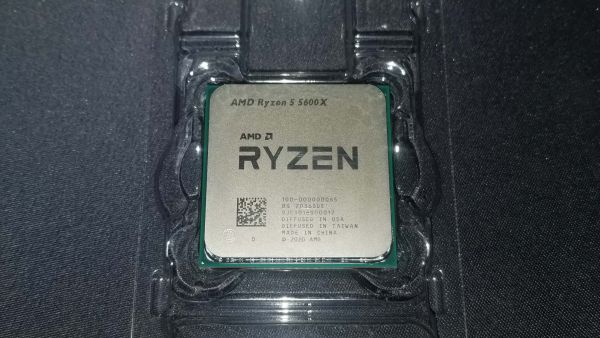Why you can trust Tom's Hardware
AMD's flagship Ryzen 9 5950X and Ryzen 9 5900X utterly devastate Intel's mainstream chips, but Intel doesn't really have comparable chips that compete on mainstream platforms.
However, Intel does have competing models for the Ryzen 5 5600X. Our results show that AMD's Zen 3 microarchitecture simply outclasses Intel's Comet Lake chips at every price point they compete in, sealing AMD's dominance in desktop PCs.
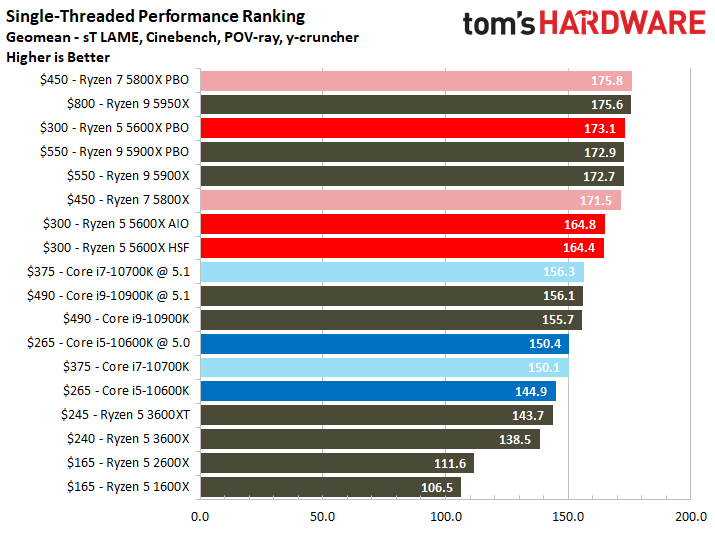
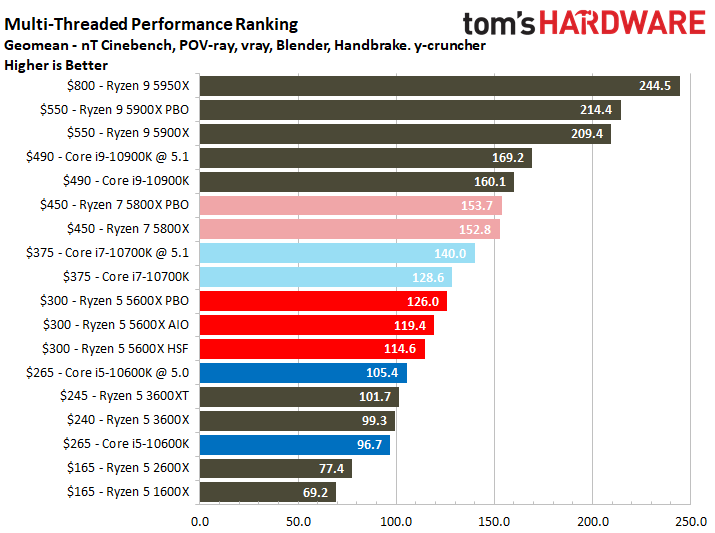
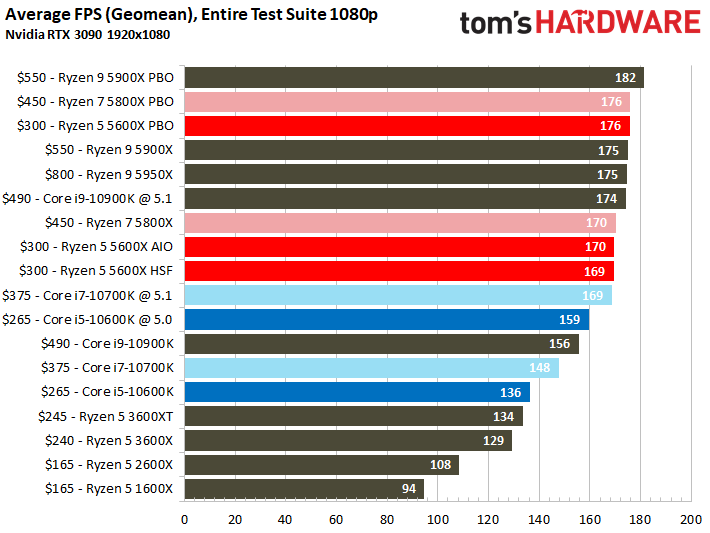
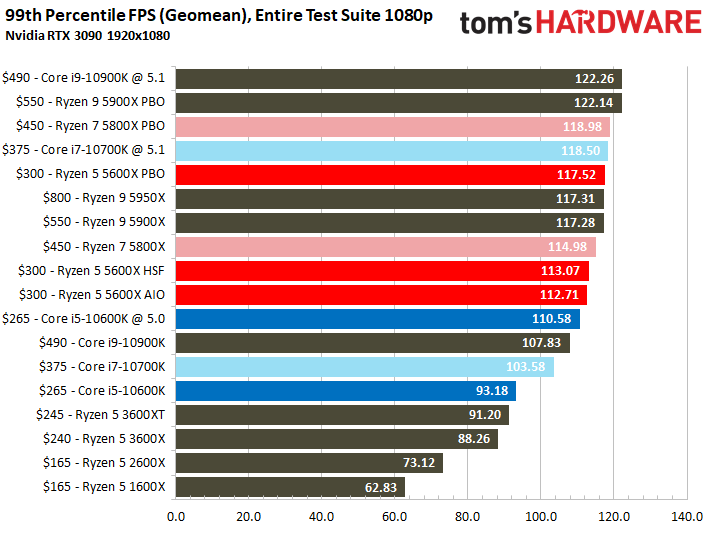
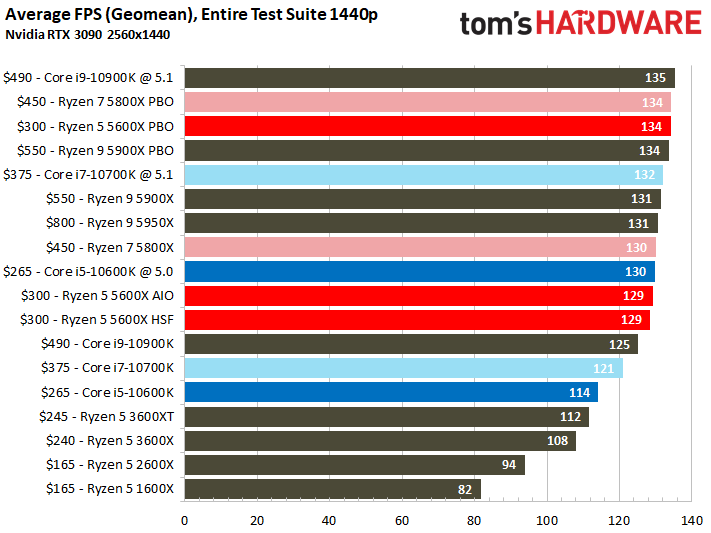
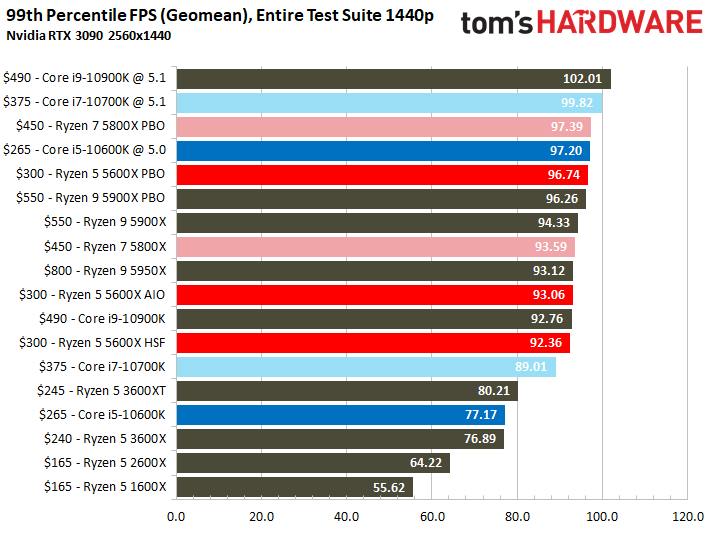
As we can see in our charts above, AMD's advantage of a denser 7nm process node and more refined architecture pays big dividends. The Ryzen 5 5600X is faster than Intel's less-expensive Core i5-10600K across the board, setting a new bar for single-threaded and multi-threaded performance in the mid-range.
Looking across the full spate of Intel chips, the Ryzen 5 5600X beats all of the Intel processors in single-threaded performance - but that's with the 5600X at stock settings. Meanwhile, even overclocking Intel's priciest mainstream silicon, the Core i9-10900K, doesn't help against the Ryzen 5 5600X at stock settings. Overclocking AMD's chip only increases its lead.
Given its price point, the Ryzen 5 5600X also delivers outstanding performance in threaded workloads, like content creation and productivity applications. You could step up $75 to the Core i7-10700K, which has two additional cores, for more performance in those types of workloads. But at that point, you'd be better off looking to AMD's Ryzen 7 5800X.
Zen 3’s gaming performance is nothing short of spectacular. The Ryzen 5 5600X is simply the mainstream chip for gaming - even Intel's mighty Core i9-10900K can't match its performance at 1080p – its only win comes after overclocking at the 1440p resolution. Naturally, the Core i5-10600K and Core i7-10700K can't compete with the Ryzen 5 5600X.
That said, as we've noted with previous AMD CPU reviews, many of those gains won’t be noticeable to users with lesser graphics cards. The tables have turned, and now Intel CPUs are the ones that are "basically just as fast as AMD" with anything short of the RTX 3080. But if you're looking for longevity, the Ryzen 5 5600X has plenty of horsepower to push future generations of graphics cards.
Get Tom's Hardware's best news and in-depth reviews, straight to your inbox.
The Ryzen 5 5600X does land at higher pricing than we're accustomed to - the $300 price tag is now the entry point for Zen 3 chips. That will change as AMD introduces its Ryzen 3 and APU models, but it is disappointing for value seekers. Unfortunately, AMD's recommended retail pricing rarely has any relation to reality at the checkout lane, so it’s hard to project where pricing will land in a few months when availability improves. For now, crushing shortages make it difficult to score a Ryzen 5 5600X, even at recommended pricing.
At least AMD includes a bundled cooler with the Ryzen 5 5600X, an advantage not given to any of its other Zen 3 processors. The Wraith Stealth cooler is adequate and provides the same performance as an AIO in single-threaded workloads and gaming, but you'll get a boost in heavy multi-threaded work if you step up to a better cooler. You'll definitely need a better cooler if overclocking is in your plans - the Wraith Spire doesn't have any additional thermal headroom.
We can expect Intel to respond with lower pricing as Zen 3 availability improves, particularly over the holiday season. Until then, if you're looking for a lower-priced alternative to the Ryzen 5 5600X, we stick with our previous recommendation of the Ryzen 5 3600 (and even the 3600X if you catch it at a good price). We simply can't recommend any competing Comet Lake processor at current pricing.
Zen 3 has completely disrupted Intel's desktop PC chips at every price point it competes in, and we're excited to see what the future Ryzen 3 and APUs have in store. Not to mention next-gen Threadripper. Meanwhile, the Ryzen 5 5600X takes the throne as the no-compromise gaming chip for the mid-range.
MORE: Best CPUs
MORE: Intel and AMD CPU Benchmarks
MORE: All CPUs Content
Current page: AMD's Zen 3 Disruption is Nearly Complete
Prev Page AMD Ryzen 5 5600X Desktop PC Application Benchmarks
Paul Alcorn is the Editor-in-Chief for Tom's Hardware US. He also writes news and reviews on CPUs, storage, and enterprise hardware.
-
Erik3135 Why is not having integrated graphics listed as a con?Reply
If you're buying basically the top gaming processor why in the world would you ever consider using integrated graphics.
If anything, it's a pro that it doesn't have integrated graphics as this way you're not paying for something you'd never use. -
glitch00 Reply
Because not everyone will be buying it for gaming. Tom's Hardware does application benchmarks after all.Erik3135 said:Why is not having integrated graphics listed as a con?
If you're buying basically the top gaming processor why in the world would you ever consider using integrated graphics.
If anything, it's a pro that it doesn't have integrated graphics as this way you're not paying for something you'd never use.
Lack of integrated graphics is a dealbreaker for me. I need something that can run multiple VMs for my ITX system and I care a lot about idle power consumption so having integrated graphics is super beneficial. I suppose AMD isn't as focused on the HTPC community since their latest APUs are OEM only. So for now, have no choice but to wait for Rocket Lake / Alder Lake / Cezanne . -
deesider Reply
I used to think Intel iGPUs were a con, but when they left them out the price didn't really changeErik3135 said:Why is not having integrated graphics listed as a con?
If you're buying basically the top gaming processor why in the world would you ever consider using integrated graphics.
If anything, it's a pro that it doesn't have integrated graphics as this way you're not paying for something you'd never use. -
Droidfreak ReplyMuch of Ryzen’s early success stemmed from industry-leading core counts and plenty of freebies for enthusiasts, like bundled coolers and unrestricted overclockability paired with broad compatibility.
"Bundled cooler" and "enthusiasts" used in one sentence? I guess we need to rethink the definition of "enthusiasts" 😁 -
dennphill From an old man that probably nobody listens to...I think AMD is laughing all the way to the bank on this price increase for the 5600X and its shortage. (I suspect they will intentionally keep stocks down to milk this shortage for all they can get!) For one, though I really liked and have always been a supporter of AMD, in this case there is no way - less a price drop to around $250 or so in the next few months - I would ever buy one of these. In protest, I woun't even consider a 3600X or a 3700X no mattert how they lower the price. I will just protest by going back to Intel when i decide I need to upgrade. AMD be cursed to the lowest level of Dante's Inferno for this trickery. That's my take on this "Knockout."Reply -
ozzuneoj So now we're calling a $299 CPU mainstream?Reply
When the 3600 was by far the best CPU purchase 4-5 months ago and was down to $165, what was it? Entry level??
The 5600X offers amazing performance at what used to be i7 prices... But I wouldn't call it mainstream. -
hotaru251 anyone else notice the typo on page 2 3rd paragraph?Reply
"Corsair H115i 280mm air cooler "
was unaware they had an air cooler sharing same name as their aio :sneaky:
yes.ozzuneoj said:When the 3600 was by far the best CPU purchase 4-5 months ago and was down to $165, what was it? Entry level??
it was the best overall cpu and everyone recommended it for balance of work and gaming.
compare its price to the price intel was use to charging for its chips.
angiven time the 5600x WILL drop to prolly around $200 which is crazy good. -
Replydennphill said:From an old man that probably nobody listens to...I think AMD is laughing all the way to the bank on this price increase for the 5600X and its shortage. (I suspect they will intentionally keep stocks down to milk this shortage for all they can get!) For one, though I really liked and have always been a supporter of AMD, in this case there is no way - less a price drop to around $250 or so in the next few months - I would ever buy one of these. In protest, I woun't even consider a 3600X or a 3700X no mattert how they lower the price. I will just protest by going back to Intel when i decide I need to upgrade. AMD be cursed to the lowest level of Dante's Inferno for this trickery. That's my take on this "Knockout."
You are free to do whatever silly thing you want to do. The competition has been raping the public for years and you’re going to go back to them? Have fun Wasting your time and your money and getting far less performance -
hotaru251 Reply
first bit:dennphill said:From an old man that probably nobody listens to...I think AMD is laughing all the way to the bank on this price increase for the 5600X and its shortage. (I suspect they will intentionally keep stocks down to milk this shortage for all they can get!) For one, though I really liked and have always been a supporter of AMD, in this case there is no way - less a price drop to around $250 or so in the next few months - I would ever buy one of these. In protest, I woun't even consider a 3600X or a 3700X no mattert how they lower the price. I will just protest by going back to Intel when i decide I need to upgrade. AMD be cursed to the lowest level of Dante's Inferno for this trickery. That's my take on this "Knockout."
you realize AMD gets the base cost paid and not the scalped prices right?
they LOSE $ by purposeful keeping stock low.
It has no benefit for them.
it's a bad time for tech (covid making worse than normal) and they have their cpu, gpu, and 2 consoles using their stuff.
fabs only have limited amount per customer.
second bit:
claism to be supporter of amd yet disses em for wanting to raise rpice a tiny bit when their cpu are THE best ones out?
and then saying you are goign back intel in future? THE intel who price gouged EVERYONE for a decade? they had price increase EVERY generation. on top of new MB required AND small increases in performance. (whereas ryzen 5000 is a HUGE increase for 1 generation)
forget supported your talking liek an intel fanboy.
"I dont like price increase for great performance so ill go to the company who nickle and dimes everyone every new cpu worse than amd ever has" -
sidesw1pe Reply
Right, so some will buy it for gaming, some will not buy it for gaming, yet it is a "con".glitch00 said:Because not everyone will be buying it for gaming.
